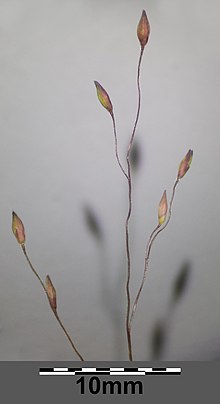Hairy millet
| Hairy millet | ||||||||||||
|---|---|---|---|---|---|---|---|---|---|---|---|---|

Hairy millet ( Panicum capillare ) |
||||||||||||
| Systematics | ||||||||||||
|
||||||||||||
| Scientific name | ||||||||||||
| Panicum capillare | ||||||||||||
| L. |
The Haarästige proso millet ( Panicum capillare ) or Haarstielige millet belonging to the genus Panicum ( Panicum ). In Lakota the species is called pejí wakán , which can be translated as "powerful herb ". The species got its name because it is often the only green grass species on the prairie in times of summer drought .
description
The Haarästige millet is a one-year , usually in clumps growing Süßgrasart . The stalks reach a height of 20 to 75 centimeters and form three to five nodes and branch out at the lower nodes. On and under the knot they are densely covered with 2 to 4 millimeter long hairs that sit on warmths. The leaf sheaths are also covered with 2 to 4 millimeter long wart hairs. The ligule is formed as a 1 to 1.5 millimeter long dense lash line. The leaf blade becomes 10 to 25 centimeters long and 4 to 12 millimeters wide and is also covered with wart hairs in the lower area, but only sparsely hairy on the upper side. Both sides of the leaf are rough. The panicle is egg-shaped or elongated, loose and widely spread, about 10 to 30 centimeters long and 6 to 15 centimeters wide and takes about 1/3 of the length of the stalk. The side branches are somewhat branched, the spikelets sit at the ends of the side branches. The spikelet stalks are thin, hairy and about 20 millimeters long. The spikelets are two-flowered, 2.4 to 3 millimeters long, narrow-elliptical and pointed. They fall off as a whole at the time of ripening. The lower glume is glabrous, three to five-nerved and about a third to half the length of the spikelet. The upper glume is also glabrous, seven-veined and of the same length as the spikelet. The lemma of the sterile lower floret is nine-veined and resembles the upper glume. The palea may be absent or otherwise approximately 2/3 the length of the lemma. The lemma of the upper hermaphrodite florets becomes 2 to 2.4 millimeters long and is smooth, glabrous and shiny. The anthers are 0.8 to 1.2 millimeters long, the fruit is slightly smaller than the lemma. Flowering time is from June to August. The contrast between immature and ripe panicles is striking: while the immature panicles are still buquet-like enveloped by the uppermost leaf flags and hang out from there like a horse's tail, the mature panicle sticks out stiff, bushy and branched in many ways.
The number of chromosomes is 2n = 18.
Distribution and location requirements
The natural range extends over the continental United States and Canada to the Caribbean, but does not extend into the northernmost regions. It is a typical grass of the prairie, particularly found in South Dakota , but less common in western North America. It is a character plant of the Great Plains , where bluegrass grows interspersed with buffalo grass . It can be found on wastelands, farms, poor soils and trampled roadsides, where it is virtually unrivaled due to its toughness.
The species is native to Europe and Russia, the West Indies, South America, North Africa, Pakistan and India. In Central Europe it is often unstable, but is often planted as an ornamental grass and allowed to grow wild. However, the species was introduced with grain, wool and clover seeds for about 100 years and was carried away with seeds and potting soil. In Central Europe, the species can be found in gardens and parks, on rubble sites and train stations, in corn fields and on sand and gravel on river banks. It continues to spread in the warmer areas and is considered a weed in corn fields. It grows in societies of the Chenopodietea class.
ecology
This annual grass is extremely tough and drought-resistant . Grazing cattle and horses spurn millet as soon as it has set seeds. This also affects the quality of the hay. On the other hand, in an area with healthy, perennial sward, the occurrence of millet cannot represent serious competition. Birds that live in the ground or visit plants, such as golden siskins , feed on the seeds.
proof
literature
- HJ Conert: Parey's book of grasses. Recognize and determine the grasses of Germany . Blackwell Wissenschafts-Verlag, Berlin, Vienna 2000, ISBN 3-8263-3327-6 , pp. 424-425 .
- James R. Johnson, Gary E. Larson: Grassland Plants of South Dakota and the Northern Great Plains . Brookings, SD 1999, ISBN 0913062065
- Rebecca Netzel: Animal Nation and Plant Nation, A Fieldguide for Lakóta Children and for all those adults who still care about Creation . Trier 2007, ISBN 978-3-88476-945-4
Individual evidence
- ↑ a b c d Conert: Parey's book of grasses
- ^ A b c d Johnson, Larson: Grassland Plants of South Dakota and the Northern Great Plains or Netzel: Animal Nation and Plant Nation, A Fieldguide for Lakóta Children and for all those adults who still care about Creation
- ↑ Panicum capillare. In: Flora of Pakistan. eFloras.org, accessed January 9, 2010 .
- ↑ Rafaël Govaerts (ed.): Panicum capillare. In: World Checklist of Selected Plant Families (WCSP) - The Board of Trustees of the Royal Botanic Gardens, Kew . Retrieved November 21, 2016.
- ↑ Panicum capillare. Germplasm Resources Information Network (GRIN), accessed January 9, 2010 .
- ^ Erich Oberdorfer : Plant-sociological excursion flora for Germany and neighboring areas . With the collaboration of Angelika Schwabe and Theo Müller. 8th, heavily revised and expanded edition. Eugen Ulmer, Stuttgart (Hohenheim) 2001, ISBN 3-8001-3131-5 , pp. 264 .






